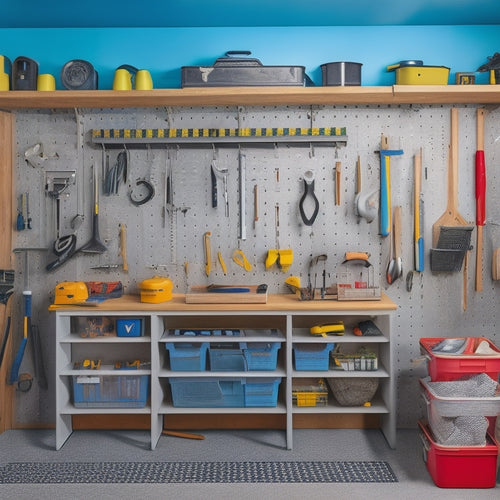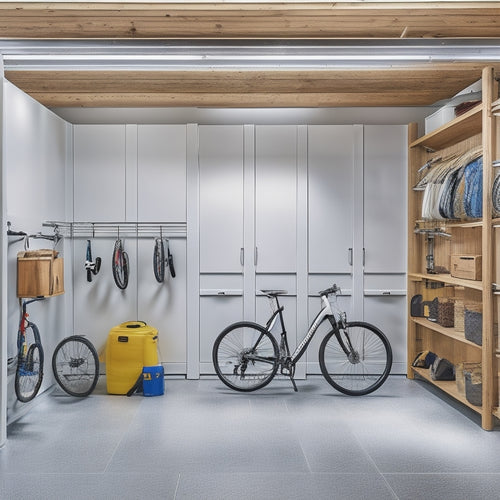
Organize Your Tool Closet in 7 Easy Steps
Share
You're about to whip your tool closet into shape in just 7 easy steps! Start by purging your tool inventory, ditching anything unused in over a year and setting aside broken tools for recycling. Next, categorize and group similar tools for easy access. Then, assign a home for each tool, considering frequency of use, and install shelving and storage units to maximize vertical space. Employ vertical space efficiently with wall-mounted racks and pegboard systems. Implement a labeling system to quickly identify tools, and finally, maintain your organized space with regular tidying and cleaning. Now you're ready to take the first step towards a clutter-free tool closet - let's get started!
Key Takeaways
- Purge and declutter your tool inventory by discarding unused or broken tools and donating gently used ones to create a more organized space.
- Categorize and group similar tools together, such as hand tools and power tools, for easy access and identification.
- Assign a home for each tool, considering frequency of use, and develop a routine for returning tools to their assigned spots after use.
- Utilize vertical space efficiently by installing wall-mounted racks, pegboard systems, and vertical containers to maximize storage capacity.
- Implement a labeling system with clear and color-coded labels to quickly identify tool categories and contents.
Purge and Declutter Tool Inventory
Organize Your Tool Closet in 7 Easy Steps
Purge and Declutter Tool Inventory
Get rid of tools you no longer need or use by going through your entire tool collection. Go through every drawer, shelf, and bin, and take out each tool. Ask yourself when you last used it and if you still need it. Be honest – if you haven't used it in a year, you probably won't miss it.
Set aside tools that are broken or damaged beyond repair and consider recycling or disposing of them safely.
Consider donating gently used tools to a local charity or community organization. Many organizations accept tool donations and use them for community projects or vocational training. You can also claim a tax deduction for your donation.
Keep track of the tools you're donating by taking photos and noting the items on an inventory spreadsheet.
As you sort through your tools, make a mental note of what you're keeping and what you're getting rid of. This will help you see what you need to restock or replace.
Categorize and Group Similar Tools
Now that you've purged your tool inventory, it's time to categorize and group similar tools.
Start by defining categories for your tools, such as "fastening", "measuring", and "cutting".
Within each category, group tool types together, like screwdrivers, wrenches, and pliers, and place similar items, like flathead and Phillips-head screwdrivers, side by side.
Tool Categories Defined
Categorizing your tools is the first step in creating a functional and efficient tool closet.
By grouping similar tools together, you'll be able to find what you need quickly and easily, saving you time and reducing frustration.
To get started, define your tool categories.
These might include:
- Hand tools: wrenches, pliers, screwdrivers, and other tools you use by hand
- Power tools: drills, saws, sanders, and other tools that require electricity or batteries
- Fasteners: nails, screws, bolts, and other items used to hold things together
- Measuring and testing tools: levels, tape measures, and multimeters
- Specialty tools: tools specific to a particular trade or task, such as plumbing or electrical work
Tool Types Grouped
How do you decide which tools to group together? Start by categorizing them into broad tool types, such as hand tools, power tools, and fasteners. Within each type, group similar tools together based on their function or usage. For example, all screwdrivers can be grouped together, and within that group, separate flathead from Phillips head screwdrivers.
| Tool Type | Sub-Group | Storage Solution |
|---|---|---|
| Hand Tools | Screwdrivers | Magnetic strip on wall |
| Power Tools | Drills | Hooks on pegboard |
| Fasteners | Nails | Small bins on shelf |
Similar Items Together
You've got your tool types grouped, and now it's time to get more specific.
Within each group, categorize and group similar tools together. This step is essential in achieving ideal tool organization and ensuring that your storage solutions are effective.
For instance, if you have a group of fastening tools, categorize them further into:
- Hand tools like pliers, wrenches, and screwdrivers
- Power tools like drills, drivers, and impact wrenches
- Fasteners like nuts, bolts, and screws
- Measuring tools like calipers and micrometers
- Accessories like bits, sockets, and adapters
Assign a Home for Each Tool
Every tool in your closet needs a designated spot where it can be easily found and retrieved. This is essential for efficient tool organization and safety. When you know exactly where each tool is, you'll avoid wasting time searching for it and reduce the risk of accidents caused by misplaced tools.
Start by grouping similar tools together, as we discussed earlier. Now, assign a specific home for each tool within those groups. For example, designate a particular hook for your hammer, a specific bin for your screwdrivers, or a certain shelf for your power tools. This way, you'll develop a routine of putting tools back in their assigned spot after use, making it a habit.
Think about the frequency of use and the size of each tool when deciding where to place them. Store frequently used tools in easy-to-reach locations, and reserve higher or lower shelves for less frequently used items.
Implementing a logical storage solution like this will streamline your tool organization and make your workspace more efficient.
Install Shelving and Storage Units
You'll find that shelving options abound, from fixed shelves to adjustable ones, and from wall-mounted to freestanding units.
As you customize storage spaces, consider the tools you've assigned a home to and the space you have available.
Now it's time to maximize your tool closet's vertical space by installing shelving and storage units that work best for your needs.
Shelving Options Abound
With your tool closet's floor cleared and sorted, it's time to think vertically and make the most of your available space.
Now it's time to choose the right shelving options to maximize storage and keep your tools within easy reach.
You've got a wide range of shelving materials to choose from, each with its own benefits.
Consider the following options:
- Adjustable shelves that can be customized to fit different tool sizes
- Wall mounted racks for hanging long-handled tools and keeping them off the floor
- Open shelving for easy access to frequently used tools and supplies
- Pegboard systems with hooks and bins for modifying your storage needs
- Heavy duty shelving for holding bulky or heavy tools and equipment
Remember to also incorporate storage bins and decorative storage units to keep small parts and supplies organized and out of the way.
Customize Storage Spaces
Tool closet alteration time has arrived! It's time to customize storage spaces to fit your specific tool organization needs.
Start by evaluating the space you have available and think about what you need to store. Consider installing custom shelves or modular storage units that can be configured to fit your unique requirements. This will help you optimize the space and guarantee that everything has a designated place.
When designing your storage layout, prioritize functional design and efficient layouts. Think about the tools you use most frequently and place them in easy-to-reach locations.
Consider creative solutions, such as DIY storage bins or baskets, to store small items like screws, nuts, and bolts.
Maximize Vertical Space
Now that you've evaluated your space and considered your storage needs, it's time to make the most of your tool closet's vertical space. By installing shelving and storage units, you'll be able to store more items while keeping your floor clear. This is especially important in a tool closet, where tripping hazards can be dangerous.
To maximize your vertical space, consider the following options:
- Wall mounted racks for hanging tools and accessories
- Pegboard systems with hooks and bins for customizable storage
- Vertical containers for storing items like paint cans and cleaning supplies
- Space saving hooks for hanging belts, hoses, and other long items
- Ceiling storage for infrequently used items, like seasonal decorations or out-of-season tools
When choosing storage units, look for adjustable shelves and magnetic strips to make the most of your space. Tool towers are also a great option, as they provide multiple levels of storage in a compact footprint.
Utilize Vertical Space Efficiently
You frequently find yourself rummaging through your tool closet, searching for that one specific screwdriver or wrench, only to realize it's buried beneath a pile of other tools. This disorganization can be frustrating and even lead to accidents. To avoid this, it's crucial to make use of your vertical space efficiently.
Consider the following options to maximize your tool closet's vertical space:
| Option | Description | Benefits |
|---|---|---|
| Wall Mounted Racks | Install racks on the walls to store tools, bins, and accessories | Saves floor space, easy access |
| Pegboard Systems | Hang pegboards on walls and add hooks, bins, and accessories | Customizable, versatile storage |
| Hanging Organizers | Suspend bins, baskets, and organizers from the ceiling | Keeps floor and shelves clear, reduces clutter |
Implement a Labeling System
With your tool closet's vertical space efficiently employed, it's time to take organization to the next level. Implementing a labeling system will help you quickly identify where each tool is stored, saving you time and frustration.
You'll need some labeling materials, such as labels, stickers, or even a label maker. Consider color coding your labels to categorize tools by type, frequency of use, or project. This will make it easy to scan the shelves and find what you need at a glance.
Here's how to get started:
- Assign a category to each shelf or section, such as "Hand Tools" or "Power Tools"
- Label each bin or container with its contents, like "Screws" or "Drill Bits"
- Use color-coded labels to differentiate between tool types, like red for power tools and blue for hand tools
- Label frequently used tools with their own unique identifier, making them easy to spot
- Create a key or legend to explain your labeling system, so you can easily reference it later
Maintain Your Organized Space
Behind a well-organized tool closet lies a commitment to maintaining that order. You've worked hard to get your tools in order, and now it's time to keep them that way. Set aside time each week to maintain your space. Put away tools after each use, and take a few minutes to tidy up your closet.
Check your storage solutions regularly to verify they're still working for you. If you find that a particular bin or shelf isn't holding up, replace it with a better option. Implement tool maintenance tips like cleaning and lubricating your tools to extend their lifespan. This will also help prevent rust and corrosion, keeping your tools safe to use.
Schedule regular deep cleans of your tool closet to keep it organized and safe. Remove everything from the shelves and dust or vacuum the space. Inspect your tools for damage or wear and tear, and make any necessary repairs.
Frequently Asked Questions
Can I Customize Shelving Units to Fit My Specific Tool Closet Needs?
You can totally customize shelving units to fit your tool closet needs! Look for custom shelving options with adjustable racks that let you tailor the layout to your specific tools and storage requirements.
How Do I Organize Tools That Don't Fit in Traditional Storage Spaces?
You'll find creative solutions for tools that don't fit traditional storage spaces by thinking outside the box - or in this case, the closet. Look for non-traditional storage options, like magnetic strips or hooks, and consider vertical solutions to maximize your space.
Are There Any Eco-Friendly Tool Storage Options Available?
You'll find eco-friendly tool storage options by opting for sustainable materials and recycled containers, like repurposed wood crates or plastic bins made from recycled materials, ensuring a safe and environmentally responsible storage solution for your tools.
Can I Organize My Tool Closet With a Limited Budget?
Carefully craft a clever closet cure-all by capitalizing on budget-friendly solutions, creatively repurposing items like old pallets or crates into creative storage spaces that'll keep your tools tidy and within easy reach.
How Often Should I Clean and Maintain My Tool Closet?
You should clean your tool closet every 1-2 months, depending on usage, and perform daily maintenance by wiping down tools and putting them back in their designated spots to prevent clutter and guarantee safety.
Conclusion
You've done it! Your tool closet is now organized and clutter-free. But here's the surprising truth: research shows that 80% of the time, you likely only use 20% of your tools. This means your newly organized space will make your most-used tools easily accessible, saving you time and frustration. By following these 7 easy steps, you've not only organized your tool closet, but also optimized your workflow.
Related Posts
-

Advantages of a Pegboard System in Your Garage
You can instantly alter your garage into a more organized, efficient, and productive space by installing a pegboard s...
-

Heavy-Duty Commercial Rolling Shelving Racks
You need heavy-duty commercial rolling shelving racks that optimize your storage capacity, streamline operations, and...
-

Modular Garage Organizers for Clutter-Free Spaces
You're likely wasting precious space in your garage due to inefficient storage and poor organization, but modular gar...


